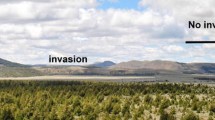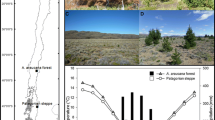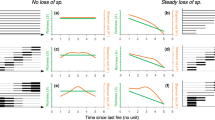Abstract
Despite the widespread perception that non-native species threaten biodiversity, there are few documented cases of non-native species displacing rare or specialized native species. Here, I examined changes in plant species composition over 5 years during patch expansion of a non-native grass, Imperata cylindrica, in longleaf pine flatwoods in Mississippi, USA. I used a multivariate approach to quantify the degree of habitat specialization and geographic range of all species encountered. I examined losses of species collectively as a function of plant height (controlling for initial frequency) and then the relationship between height and the degree of association with longleaf pine flatwoods, disturbed habitats, and the outer Gulf Coastal Plain of the southeastern USA. Patch expansion resulted in dramatic declines in species richness and increases in ground-level shade at both sites in just 3 years. Most tall saplings, shrubs, and vines were not endemic to longleaf pine communities and were less likely to be displaced than short herbs, most of which were indicative of longleaf pine communities. These results suggest that invasion of longleaf pine communities by I. cylindrica will likely cause significant losses of short, habitat-specialists and reduce the distinctiveness of the native flora of these threatened ecosystems.



Similar content being viewed by others
References
Alverson WS, Kuhlmann W, Waller DM (1990) Wild forests: conservation biology and public policy. Island Press, Washington, DC
Anderson MJ (2001) A new method for non-parametric multivariate analysis of variance. Austral Ecol 26:32–46
Brewer JS, Cralle SP (2003) Phosphorus addition reduces invasion of a longleaf pine savanna (Southeastern USA) by a non-indigenous grass (Imperata cylindrica). Plant Ecol 167:237–245
Brown JH, Sax DF (2004) An essay on some topics concerning invasive species. Austral Ecol 29:530–536
Brown JH, Sax DF (2005) Biological invasions and scientific objectivity: reply to Cassey et al. (2005). Austral Ecol 30:481–483
Bruno JF, Fridley JD, Bromberg KD, Bertness MD (2005) Insights into biotic interactions from studies of species invasions. In: Sax DF, Stachowicz JJ, Gaines SD (eds) Species invasions: insights into ecology, evolution, and biogeography. Sinauer Associates, Inc., Sunderland, Massachusetts, pp 13–40
Bryson CT, Carter R (1993) Cogongrass, Imperata cylindrica, in the United States. Weed Technol 7:1005–1009
Callaway RM, Aschehoug ET (2000) Invasive plants versus their new and old neighbors: a mechanism for exotic invasion. Science 290:521–523
Campbell BD, Grime JP (1992) An experimental test of plant strategy theory. Ecology 73:15–29
Cassey P, Blackburn TM, Duncan RP, Chown SL (2005) Concerning invasive species: reply to Brown and Sax. Austral Ecol 30:475–480
Clewell AF (1985) Guide to the vascular plants of the Florida panhandle. The Florida State University Press, Tallahassee, Florida
Davis MA (2003) Biotic globalization: does competition from introduced species threaten biodiversity? Bioscience 53:481–489
Dozier H, Gaffney JF, McDonald SK, Johnson ER, Shilling DG (1998) Cogongrass in the United States: history, ecology, impacts, and management. Weed Technol 12:737–743
Funk JL, Vitousek PM (2007) Resource-use efficiency and plant invasion in low-resource systems. Nature 446:1079–1081
Frost CC (1993) Four centuries of changing landscape patterns in the longleaf pine ecosystem. Proc Tall Timbers Fire Ecol Conf 18:17–43
Glitzenstein JS, Streng DR, Wade DD (2003) Fire frequency effects on longleaf pine (Pinus palustris P. Miller) vegetation in South Carolina and northeast Florida, USA. Nat Areas J 23:22–37
Gurevitch J, Padilla DK (2004) Are invasive species a major cause of extinctions? Trends Ecol Evol 19:470–474
Holm LG, Plucknett DL, Pancho JV, Herberger JP (1977) The world’s worst weeds: distribution and biology. The University of Hawaii Press, Honolulu, HI, USA, 609 pp
Huenneke LF, Thompson JK (1995) Potential interference between a threatened endemic thistle and an invasive nonnative plant. Conserv Biol 9:416–425
King SM, Grace JB (2000) The effects of gap size and disturbance type on invasion of wet pine savanna by cogongrass, Imperata cylindrica (Poaceae). Am J Bot 87:1279–1286
Klironomos JN (2002) Feedback with soil biota contributes to plant rarity and invasiveness in communities. Nature 417:67–70
Kuusipalo J, Ådjers G, Jafarsidik Y, Otsamo A, Tuomela K, Vuokko R (1995) Restoration of natural vegetation in degraded Imperata cylindrica grassland: understory development in forest plantations. J Veg Sci 6:205–210
Lawton JH, May RM (eds) (1995) Extinction rates. Oxford University Press, Oxford, UK
Leach MK, Givnish TJ (1996) Ecological determinants of species loss in remnant prairies. Science 273:1555–1558
Levine JM, D’Antonio CM (1999) Elton revisited: a review of evidence linking diversity and invasibility. Oikos 87:15–26
Lippincott CL (1997) Ecological consequences of Imperata cylindrica (cogongrass) invasion in Florida sandhill. Ph.D. dissertation, University of Florida, Gainesville, Florida, USA
Lippincott CL (2000) Effects of Imperata cylindrica (L.) Beauv. (cogongrass) invasion on fire regime in Florida sandhill. Nat Areas J 20:140–149
Nee S, May RM (1992) Dynamics of metapopulations: habitat destruction and competitive coexistence. J Anim Ecol 61:37–40
Noss RF (1988) The longleaf pine landscape of the southeast: almost gone and almost forgotten. Endangered Spec Update 5:16
Peet RK, Allard DJ (1993) Longleaf pine vegetation of the southern Atlantic and eastern Gulf Coast regions: a preliminary classification. Proc Tall Timbers Fire Ecol Conf 18:45–81
Platt WJ, Weiss IM (1977) Resource partitioning and competition within a guild of fugitive prairie plants. Am Nat 111:479–513
Premalal KPSB, Meylemans B, Sangakkara UR, Van Damme P (1995) Depression of growth of spear grass (Imperata cylindrica) by velvet bean (Mucuna pruriens). Mededelingen Faculteit Landbouwkundige en Toegepaste Biologische Wetenschappen Universiteit Gent 60:213–216
Rabinowitz D, Rapp JK, Cairns S, Mayer M (1989) The persistence of rare prairie grasses in Missouri: environmental variation buffered by reproductive output of sparse species. Am Nat 134:525–544
Radford AR, Ahles HA, Bell CR (1968) Manual of the vascular plants of the Carolinas. University of North Carolina Press, Chapel Hill, North Carolina, USA
Simberloff D (1981) Community effects of introduced species. In: Nitecki MH (ed) Biotic crises in ecological and evolutionary time. Academic Press, New York, pp 53–81
Walker J (1993) Rare vascular plant taxa associated with the longleaf pine ecosystems: patterns in taxonomy and ecology. Proc Tall Timbers Fire Ecol Conf 18:105–125
Acknowledgments
I thank Gomez Parker of the University of Mississippi Forest Lands and the Fire Crew at Desoto National Forest for technical assistance and access to the sites, and Ashley Cain, Allison Grisham, Alex Pabst, and Sean Cralle for assistance in the field, and two anonymous reviewers and associate editor P. Alpert. Support for this project was provided by a grant from the University of Mississippi Faculty Summer Support Program.
Author information
Authors and Affiliations
Corresponding author
Rights and permissions
About this article
Cite this article
Brewer, S. Declines in plant species richness and endemic plant species in longleaf pine savannas invaded by Imperata cylindrica . Biol Invasions 10, 1257–1264 (2008). https://doi.org/10.1007/s10530-007-9200-3
Received:
Accepted:
Published:
Issue Date:
DOI: https://doi.org/10.1007/s10530-007-9200-3




